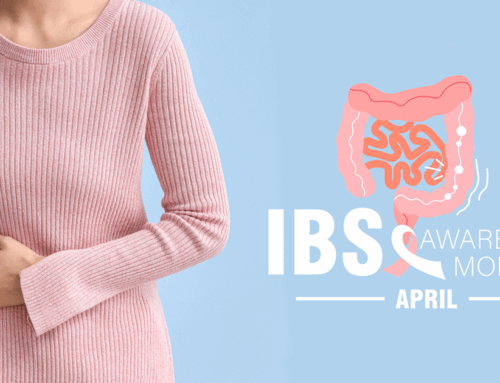Have you ever noticed that your gut feels sluggish when you consume too many processed foods? Often, eating whole foods rich in fiber is the kickstart your gut needs to get things moving again.
Fiber is an essential component of a balanced diet. However, most Americans consume less than half the recommended daily fiber intake.
Keep reading to learn all about fiber and how you can add more of it to your diet.
What Is Dietary Fiber?
Dietary fiber is an indigestible type of carbohydrate that occurs naturally in plant-based foods like fruits, vegetables, grains, legumes, nuts, and seeds. Humans are unable to digest fiber because we don’t have the necessary digestive enzyme.
There are two forms of dietary fiber: soluble fiber and insoluble fiber. These fibers play specialized roles in your digestive system.

Soluble Fiber
Soluble fiber dissolves in water and forms a gel in your intestines. This gel-like substance slows down digestion and increases the time it takes for stool to move through your gastrointestinal tract. Eating foods with soluble fiber can prevent the onset of diarrhea.
Some soluble fibers are also prebiotics. This means that they feed the healthy bacteria in your gut.
Insoluble Fiber
Unlike soluble fiber, insoluble fiber stays intact throughout your digestive system. This form of fiber speeds up the movement of stool through your gastrointestinal tract. Adding insoluble fiber to your diet can improve the regularity of bowel movements and prevent constipation.
How Much Fiber Should I Eat?
There is no limit to how much fiber you can eat. However, it would be best if you slowly increased your fiber intake so your body can properly adjust. The overconsumption of dietary fiber can lead to uncomfortable side effects like bloating, gas, and abdominal discomfort.
The recommended daily fiber intake varies depending on the person. You can find your recommended intake below:
- Men aged 19 to 50 should consume 38 grams of fiber per day
- Women aged 19 to 50 should consume 25 grams of fiber daily
- Men aged 51+ should consume 31 grams of fiber per day
- Women aged 51+ should consume 21 grams of fiber daily
Eating a diverse selection of plant-based foods can help you meet your daily fiber needs. For example, half a cup of rolled oats contains 4 grams of fiber, one large banana contains 3.5 grams of fiber, and half a cup of black beans contains 7.5 grams of fiber.
Foods High in Fiber
Insoluble fiber foods include:
- Whole grains
- Bran
- Nuts
- Seeds
- Beans
- Cauliflower
- Green beans
- Potatoes
Soluble fiber foods include:
- Carrots
- Broccoli
- Onion
- Artichokes
- Bananas
- Berries
- Apples
- Pears
- Beans
- Oats
- Barley
Digestive Health Benefits of Fiber
You can reap the health benefits of fiber by eating a plant-based diet. Keep reading to learn more about how fiber positively affects your digestive system.
Easy-to-Pass Stools
Fiber improves bowel motility and can prevent complications related to the formation of hard, painful stools.
The large, rough particles of insoluble fiber pass through your digestive system intact. These fibers irritate the intestines’ inner lining, which stimulates water and mucous secretion to prevent damage to the intestinal mucosal barrier. This increase in stool water content results in softer and bulkier stools.
Gel-forming soluble fibers also attract water into the gut. Collectively, insoluble and soluble fibers act as a laxative and improve your ability to pass stools.
Improved Metabolic Health
Gel-forming soluble fibers such as beta-glucans, psyllium, and raw guar gum lower cholesterol levels and improve glycemic control.
Soluble fiber reduces the concentration of low-density lipoproteins (LDL) by binding to cholesterol particles in the small intestine. LDL is the bad form of cholesterol that clogs your arteries. Your body excretes the trapped cholesterol in stool, which lowers both LDL cholesterol and total cholesterol levels.
Soluble fiber also enhances insulin sensitivity and lowers fasting blood sugar levels. The gel-like consistency of soluble fiber slows the absorption of glucose in the small intestine. This prevents your blood sugar from spiking after meals.
Remarkably, adding more soluble fiber to your diet can lower your heart disease risk and type 2 diabetes.
Stronger Immune System
Did you know that 70% of your immune system resides in your gut? Naturally, it makes sense that feeding beneficial gut bacteria with prebiotic fiber can strengthen your immune system. The fermentation of prebiotic fiber produces metabolites that enhance your body’s immune response.
Foods that contain prebiotic fiber include:
- Leeks
- Asparagus
- Onions
- Wheat
- Garlic
- Oats
- Soybeans
- Artichokes
Reduced Risk of Colon Cancer
Adding more dietary fiber to your diet can reduce your risk of colon cancer. Research suggests that every 10 grams of fiber you eat lessens your colon cancer risk by 10%. Your risk of colon cancer subsides even more if you eat additional servings of dietary fiber.
Increasing your fiber intake improves bowel motility, which decreases your exposure to fecal carcinogens. It also allows gut bacteria to ferment some forms of soluble fiber and produce metabolites with anti-carcinogenic properties.
Low Fiber Diet Side Effects
A low fiber diet can have adverse effects on your gut health. If you don’t eat enough fiber, you may find yourself having difficulty passing stools. This one problem can result in many more if left untreated.
Side effects of a low-fiber diet may include:
- Hemorrhoids
- Constipation
- Abdominal pain
- Anal fissures
If you’re dealing with any of the above symptoms, try adding more fiber to your diet. If your symptoms don’t resolve within a few weeks after making healthy changes, you should see a gastroenterologist. Sometimes, digestive symptoms are a sign of a more significant problem.
If you want to improve your digestive health, you can make an appointment online or call our office at 972-867-0019.





